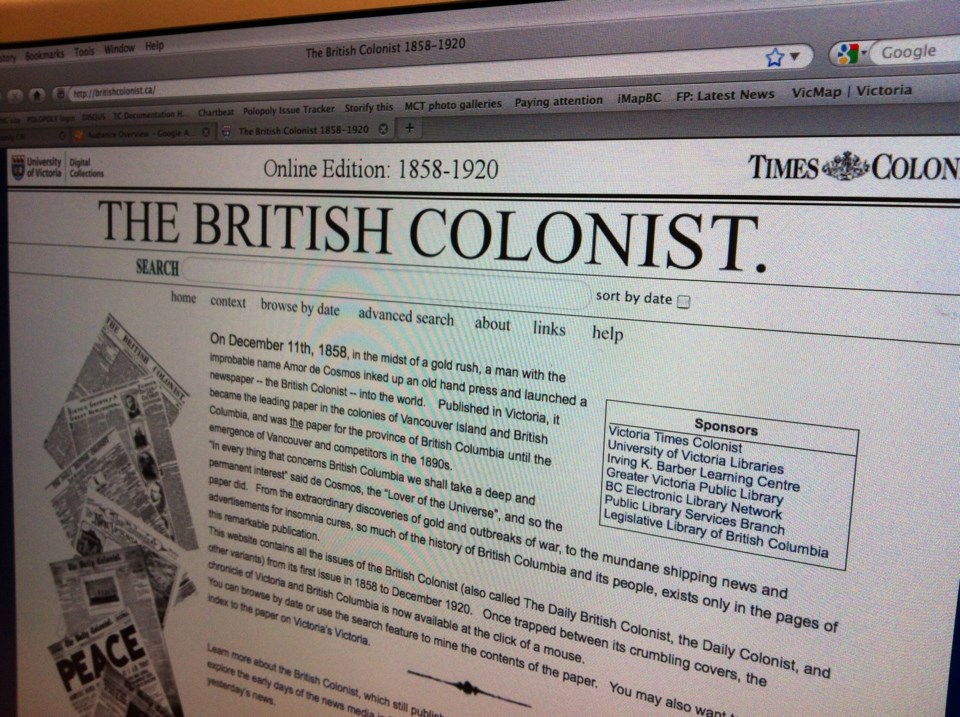It’s our birthday today. It’s been 155 years since Amor De Cosmos launched the four-page British Colonist. The newspaper you are holding in your hands — or reading online, or on your mobile device — is a direct descendant of his first issue, on Dec. 11, 1858.
The Times Colonist is the oldest newspaper in Western Canada. We were here before Canada was a nation and before British Columbia was a province.
What we have published in 155 years of continuous community service represents a massive storehouse of information, history written on the fly, about Victoria and Vancouver Island.
Five years ago, as part of our 150th anniversary celebration, the British Colonist and its successors — the Daily Colonist and so on — up to 1910 were digitized and placed online at britishcolonist.ca.
That website revolutionized the way that B.C. history is researched and taught, making old news stories or advertisements searchable on your computer.
It has also been a great equalizer; school students in the smallest communities can use a resource that previously was available only at libraries in the big cities.
This incredible website would not have been possible without the help of partners, including the Public Library Services Branch (now the Libraries and Literacy Branch), the Ike K. Barber Learning Centre, the Greater Victoria Public Library, the Legislative Library, the B.C. Electronic Library Network, and above all else, the University of Victoria Library.
UVic staff members have done most of the grunt work needed to get these old newspapers in front of a new audience. Officially, britishcolonist.ca is part of UVic’s digital collections and is one of the most popular features in that collection.
It’s about to get much, much busier. The website has just been expanded to include all of the Colonist issues from 1910 to 1920, arguably the most newsworthy decade in our history.
Here’s a flash summary.
The Great War meant that hundreds of local people are buried in military cemeteries in Belgium and northern France.
The Willows exhibition buildings were converted into a training camp. Premier Richard McBride bought a couple of submarines. Arthur Currie rose from the local militia to become Canada’s top commander. There were anti-German riots downtown. Craigdarroch Castle was converted into housing for returned soldiers.
The decade opened with an economic boom that turned into a slump in 1913. As a result of that boom, we saw several new buildings that are still here, including the Wilkinson Road jail, the Royal and McPherson theatres and Victoria High School. Other buildings from that era, such as the Patrick ice rink, are gone.
The Uplands and the Malahat were opened, along with the Saanich interurban railway and the Ogden Point breakwater.
Women won the right to vote in provincial elections. Mary Ellen Smith became the first female MLA when she was elected to succeed her late husband.
The Komagata Maru cleared the William Head quarantine station before being turned away in Vancouver.
Albert “Ginger” Goodwin was killed in the bush near Cumberland, inspiring the first general strike in Canadian history.
William Wallace Gibson developed the first Canadian airplane engine and flew his airplane near Mount Tolmie in September 1910.
A smashing summer carnival in 1913 was marred by the death of an American pilot in a crash in Chinatown. It was Canada’s first air fatality.
Stan Laurel played the Pantages theatre. The Victoria hockey team beat the Stanley Cup champions. Prohibition started. The public library launched a children’s section.
We lost the Titanic. Closer to home, the sinking of the steamer Sechelt, serving the Victoria-Sooke route, killed 21 people. The Canadian Pacific ship Princess Sophia became stuck on a reef near Juneau, Alaska, and all 343 men, women and children on board died.
An influenza epidemic killed about 20 million people.
Want more? Want to read about politics, people, society, entertainment, sports and more? From 1858 to 1920, it’s available on britishcolonist.ca. And it’s free.
The website is just one example of our dedication to this community — a dedication that has stayed strong for 155 years.



